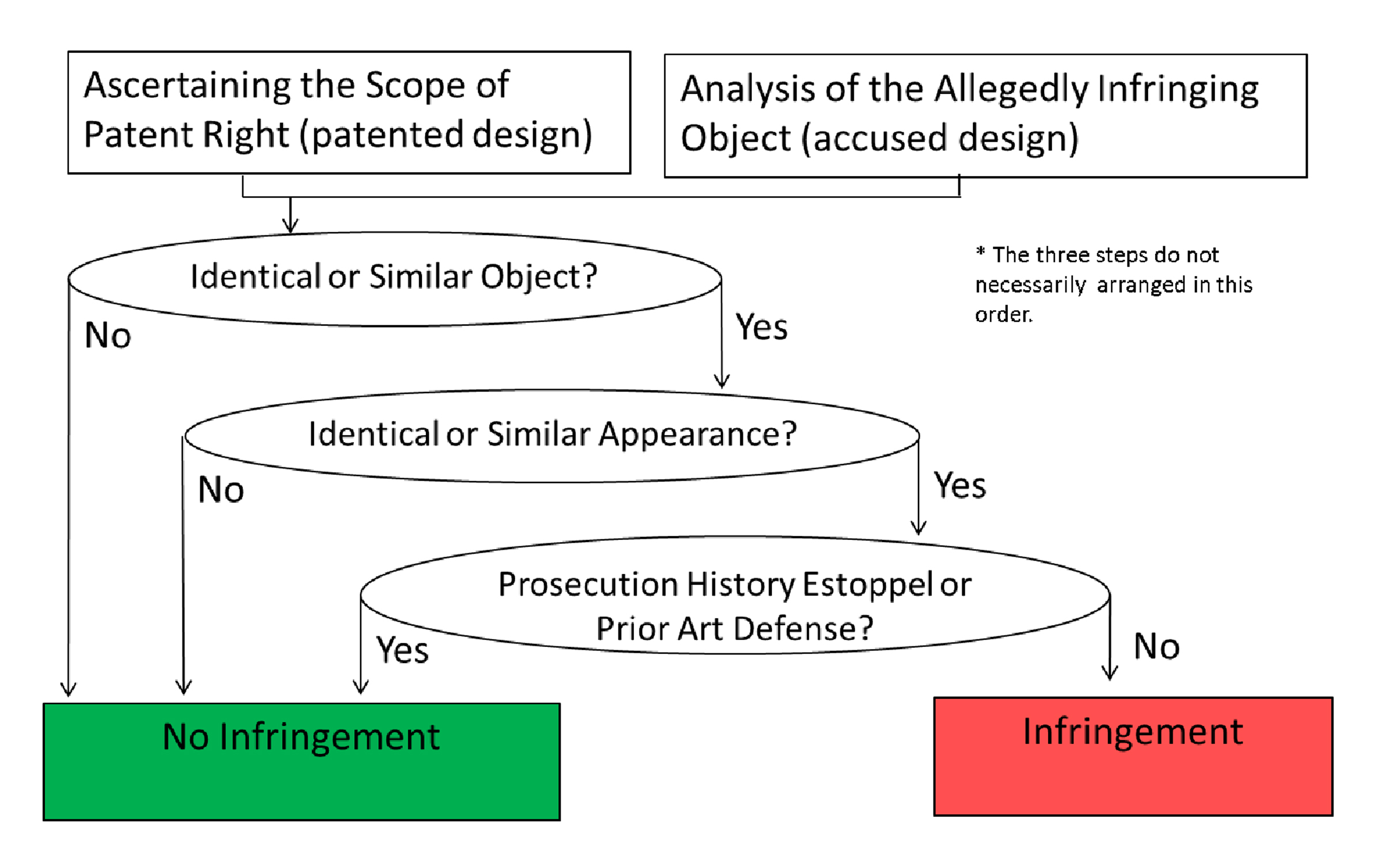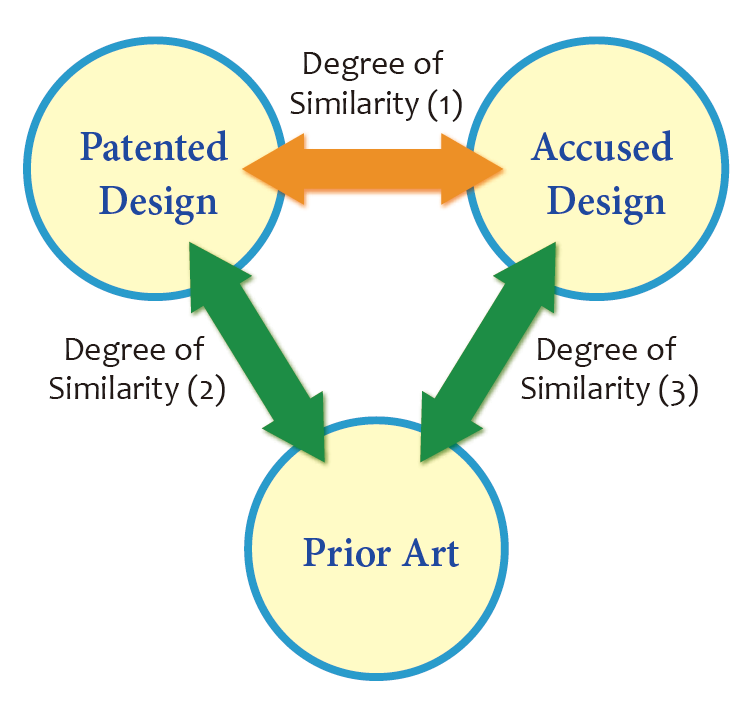Briefs on the Directions for Determining Patent Infringement - Design Chapter
published on 31 Jul 2016
1. INTRODUCTION
Taiwan Intellectual Property Office revised the “Directions for Patent Infringement Assessment” in February. The revision was made with considerable modifications in reference to foreign rulings and respective literature from nations including the U.S., Japan, and China. The document has been renamed as the “Directions for Determining Patent Infringement” (Directions).
With respect to design patents, major revisions have been made to the general procedure for determination, the measures to ascertaining the scope of a patent, the subject according to whom the determined will be made, the three-way visual comparison, and the infringement determination for new types of protectable designs.
2. REVISION SUMMARY
1)General Procedure for Determining Design Patent Infringement

The procedure consists of two stages. The first stage is interpretation of patent scope, while the second stage requires a comparison between the entire patented design with the corresponding scope of the accused design employed on the allegedly infringing article. The second stage can be further divided into four steps which are:(1)Resolving the allegedly infringing article;
(2)Deciding whether the articles on which the two designs applied are identical or similar;
(3)Determining whether the two appearances are identical or similar; and
(4)Checking whether prosecution history estoppel or prior art defense is available.
Notably the latter three steps are not necessarily carried out in the given numbered order. Namely, observations for similarity and identity of the article and appearance do not have to precede the investigation for prosecution history estoppel/prior art defense. Furthermore, in cases where the accused infringer raises one or both of the defenses, its related argument shall be reviewed and weighted simultaneously with step (2) and (3). When a defense is entered, the court may directly rule for non-infringement even without analyzing the degree of similarity or identity.
Significantly, the previously required step of deciding if the accused design comprises any “novel features” has now been deleted, according to the Directions.
2) The Principle and Concept for Patent Scope Interpretation
The patent scope of a claimed design is dependent on the drawings; the description may be considered as a reference only. Determination of design patent scope serves to correctly identify the presented appearance and article for which the patented design has been applied. Only when the scope has been reasonably determined can it be used as the comparison basis. In the Directions, the scope of patented design no longer needs to be translated into a literal description before the comparison. However, the following instances may be elaborated as auxiliary means aiding the course of determination, if necessary:
· The general methods used for preparing drawings, such as the meaning of dotted lines used in the drawings;
· Passages in the file wrappers where the scope of patented design is referred or related;
· Differentiate visual features from functional ones that are disclosed; etc.
The constitution of the patented design should be identified as an integration of the shapes, patterns, and colors that are disclosed by all views in the drawings. The design features disclosed by each of the view should all be weighted. Moreover, one cannot preclude a feature of the designed article from comprehensive evaluation only because it is either visible or invisible when used or only because it is also functional.
According to the Directions, “intrinsic evidence” for determining design patent scope includes the related prior patent applications and associated prosecution history files. The hierarchy of intrinsic evidence precedes that of the extrinsic ones in terms of the order of adoption. When conflicts between the two arise, intrinsic evidence prevails.
Scope of a design patent is consists of an “article” and its “appearance,” both of which are based on the drawings with reference to the description in the specification. For a design which has a changing appearance, for instance a transformable robot toy, or a graphic design having a changeable appearance, the patent scope shall be determined based on all changing states disclosed in the drawings. In the event where the changing is continuous and dynamic, the order of changing described shall also be considered.
3) Construing Patent Scope for New Types of Designs
There were four newly eligible designs recently introduced by the Amendment to the Patent Act 2011, namely the partial designs, graphic designs, designs of a set of articles, and derivative designs. The core methodology of patent scope interpretation for these designs is how the “portions claimed for protection” (claimed portions) are identified from “portions not claimed for protection” (unclaimed portions). Particularly, when disclosure of the drawings is indefinite such that the scope thereof cannot be ascertained even after referring to specification and other evidence, the protection shall be construed by the “narrower scope,” based on the patent validity assumption. For graphic designs, the bordering line used to indicate a claimed design does not serve any limitation over the graphic’s position, size, and distribution in the situated environment.
Page 67-75 of the Directions comprehensively lists further descriptions and examples in detail.
4) Reference Subject for Determining Infringement
In the first stage for interpreting the patent scope, the Directions replace the viewpoint of a PHOSITA (“person having ordinary skill in the art”) by an “ordinary consumer” as the subject for determination. An ordinary consumer is further defined as an individual who has a general level of knowledge and understanding regarding the article and therefore is reasonably familiar with said article. By referring to the prior arts in the field of the article, an ordinary consumer is able to fairly identify the difference between the allegedly infringing article’s design and the patented design. Notably, an ordinary consumer is not the one being familiar with the sales and marketing of the article but merely being a person who is familiar with the article and similar prior art. (Level of familiarity of prior art goes by: expert and professional designer > PHOSITA > ordinary consumer who is reasonably familiar with the article and similar prior art > consumer)
5) Resolving the Allegedly Infringing Article
When resolving the allegedly infringing article, it shall be compared with the corresponding scope of the patented design. Irrelevant areas of the appearance shall not be included for comparison. Page 76-77 of the Directions comprehensively lists further descriptions and examples in detail.
6) Tests for Comparison and Determination
Identity and similarity comparison of the designed articles and the appearances are two steps for determining design patent infringement, as aforementioned. Essentially, articles with the same uses are the same articles whereas articles of similar uses are similar articles. On the other hand, while “identical appearance” means complete consistency and conformity of the shape, pattern and color between the accused design and the patented design, “similar appearance” suggests the overall appearances of the two designs embrace no substantial difference. . There are three approaches for comparison as follows:
a. Straight observation:
Based on ordinary consumer’s shopping habits, the approach of straight observation requires one to observe directly via naked eye without the aid of instruments which may enhance nuances. In other words, by using straight observation, one shall no longer isolate the accused infringing article from the patented one and then observe their differences in different time and places, in order to avoid holding a vague memory as the basis for determining similarity or identity.
b. Overall observation and integrative determination:
First observe and compare the design features of the two in order to analyze the difference, and then integratively weight the contribution of all features to the entire design concept through the viewpoint of an ordinary consumer. See page 79 of the Directions for further descriptions and examples in detail.
c. Three-way visual comparison test:

This approach is newly introduced in the Directions. It is an auxiliary method for determining similarity. Methodologically this approach analyzes the degree of similarity among the “patented design”, the “accused design”, and the “closest prior art” in the relevant art where the design patent belongs to. The three-way test applies when the accused design and the patented patent are not plainly similar, or it is unclear whether or not they are similar.
In sum, the accused design and the patented design are similar if the degree of similarity between patented design and the accused design is higher than that between patented design and the closest prior art, and if the similarity is also higher than that between the accused design and the closest prior art. See page 80-81 of the Directions for further descriptions and examples in detail.
7) Infringement Determination for New Types of Designs
a. Partial Design
Whether the articles are similar depend on the articles the design applied on or its overall usage, the corresponding scope of the accused article and the design patent. The conclusion will be the integrative comparison of identity or similarity for the “claimed portions” and the “unclaimed portions.”
The table below explains how the determination will be made: See page 87-83 for more description in detail.
|
Comparing the “claimed portions” with the corresponding scope of the accused article
|
+
|
Comparing the interrelation between location, size, and distribution of the “unclaimed portions” with the corresponding scope of the accused infringing article
|
→
|
Determination of similarity or identity
|
|
Identical
|
+
|
Identical or substantially identical
|
→
|
Identical in appearances
|
|
Identical or similar
|
+
|
Difference exists between the two designs and their interrelation with their respective environment situated
|
→
|
(essentially) Similar in appearances
|
|
Identical or similar
|
+
|
Despite difference exists as to the interrelation between the designs and their respective environment situated, the difference is not a common design approach used in the related filed of the article.
|
→
|
Not identical nor similar in appearance
|
|
Not identical nor similar
|
+
|
N/A
|
→
|
Not identical nor similar in appearance
|
b. Graphic Design
Identity or similarity of appearance shall firstly be dependent on the “claimed portions” of the drawing (often the scope presented in the figures). Also, by considering the “unclaimed portions” to confirm the interrelation between the environment and the location, size, and distribution of the “claimed portions,” one therefore may further compare the corresponding scope of the accused design and reach a conclusion. See page 83-92 for more description in detail.
c. Design as a set
The appearance of the entire set of articles disclosed by the patent drawings is the criterion for determining identity or similarity. What is to be compared is the integrative visual image of the patented design and the corresponding scope of the accused design. See page 92-95 for more description in detail.
d. Derivative Design
For derivative designs, abovementioned techniques shall apply and the parent design may serve as a reference. See page 95-96 for more description in detail.
8) Defense
Available defenses can be prosecution history estoppel or prior art defense. In the former case, by demonstrating with relevant evidence that the scope of similarity was ever restricted, denounced, or precluded by the applicant/patentee during the course of patent prosecution and enforcement, the alleged infringer can defend against the infringement claim. In the latter situation, on the other hand, if evidence indicates that the accused design is similar or identical to prior art, no infringement will be found. See page 97-98 for more description in detail.
3. CONLCUSION
The Directions are substantially modified and renamed as an effort to stay aligned with amendments to the Patent Act, as a reference to the court and both litigating parties. The Directions includes many examples to illustrate patent scope interpretation and infringement determination. For the reader’s interest, please refer to respective page number noted at each paragraph to review those examples.
|